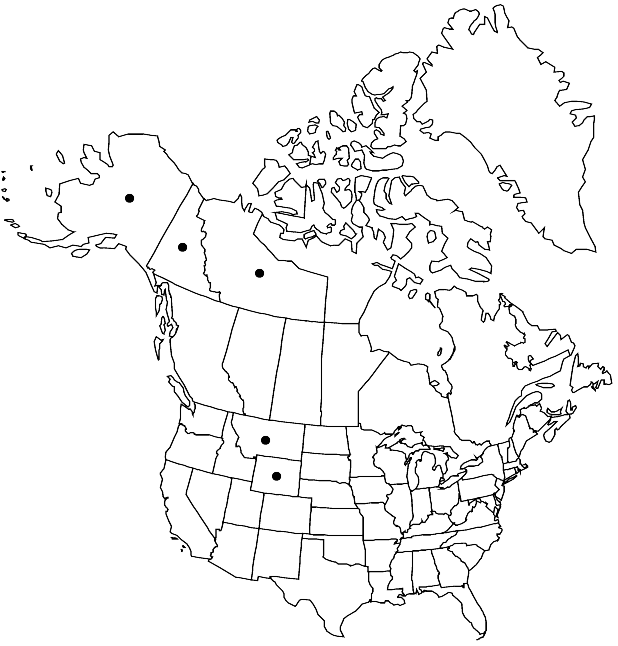Salix rotundifolia
Nouv. Mém. Soc. Imp. Naturalistes Moscou 2: 304, plate 11. 1832.
Plants 0.005–0.05 m, (dwarf), forming clones by rhizomes. Stems erect; branches yellow-green, yellow-brown, or gray-brown, glabrous; branchlets yellow-brown or red-brown, glabrous; branches and branchlets sometimes weakly glaucous. Leaves (marcescent but not skeletonized), stipules usually absent or rudimentary, rarely present on late ones; petiole (convex, or shallowly to deeply grooved, flat), 0.4–4.6(–5.5) mm, (glabrous adaxially); largest medial blade (2 pairs of secondary veins arising at or close to base, arcing toward apex) broadly elliptic, subcircular, or circular, 1.9–16.3 × 3–10.5 mm, 0.84–1.17(–2.53) times as long as wide, base rounded or convex, margins flat, entire, ciliate, apex retuse, rounded, convex, or acute, abaxial surface glabrous, adaxial highly glossy, glabrous; proximal blade margins entire; juvenile blade glabrous or puberulent. Catkins from subterminal buds; staminate subglobose, stout, or indeterminate, 3.3–18.5 × 2.5–12 mm, flowering branchlet 0.5–9 mm; pistillate moderately densely to loosely flowered (2–15 flowers), stout, subglobose, globose, or indeterminate, 4.5–35 × 2–17 mm, flowering branchlet 0.5–22 mm; floral bract brown, 1.6–2.8 mm, apex rounded or retuse, entire, abaxially sparsely hairy or ciliate, hairs usually wavy, crinkled or curly, rarely straight. Staminate flowers: abaxial nectary 0.5–1 mm, adaxial nectary narrowly oblong or oblong, 0.8–1.4 mm, nectaries distinct; filaments distinct or connate less than 1/2 their lengths, glabrous; anthers ellipsoid or globose, 0.4–0.6 mm. Pistillate flowers: abaxial nectary present or absent, adaxial nectary usually narrowly oblong or oblong, sometimes flask-shaped, 0.8–2 mm, longer than stipe; stipe 0.4–0.8 mm; ovary pyriform, glabrous or puberulent, (hairs in patches, especially on beak), beak slightly bulged below styles; ovules 7–17 per ovary; styles connate or slightly distinct distally, 0.5–1 mm; stigmas flat, abaxially non-papillate with pointed tip, or slenderly or broadly cylindrical, 0.28–0.6 mm. Capsules 3.8–8.3 mm.
Distribution

N.W.T., Yukon, Alaska, Mont., Wyo., e Asia.
Discussion
Varieties 2 (2 in the flora).
Salix rotundifolia is closely related to S. polaris, from which it can be separated by its glabrous ovaries and fewer-flowered catkins. They also differ somewhat in leaf venation: S. rotundifolia typically having three main veins arising from the leaf base, often only one or two pair of secondary veins, and no or indistinct tertiary veins; S. polaris typically having pinnate venation, multiple secondary veins, and distinct tertiary veins. Salix rotundifolia consists of two varieties, the diploid var. dodgeana and the hexaploid var. rotundifolia. In general, var. dodgeana is a high alpine species in the southern cordillera of Wyoming and Montana, the St. Elias Mountains in Alaska and Yukon, the Mackenzie Mountains, Northwest Territories, and the Richardson Mountains, Yukon Territory. A diploid specimen of S. rotundifolia in the Cherski Mountains, Yakutia, Russia (B. A. Jurtzev and P. G. Zhukova 1982), which fits var. dodgeana in its 2–3-flowered catkins, relatively small leaves (3.5 × 3.9 mm), and small stomata (490 µm2), may represent an ancestral population. Variety rotundifolia usually occurs at lower elevations in Alaska and in easternmost Chukotka and Wrangel Island, Russia, but elevation separation is not distinct. There is a general correlation between stomatal size and ploidal level (W. Buechler, pers. comm.), but relatively large stomata in some diploid specimens of S. rotundifolia indicates a need for further cytological study. For the present, it is best to recognize the two cytotypes as varieties.
Hybrids:
Salix rotundifolia forms natural hybrids with S. arctica, S. phlebophylla, and S. polaris.
Selected References
None.
Key
| 1 | Pistillate catkins: (3-)4-7-15 flowers; largest medial blades 4.5-8-16.3 mm, 0.92-1.23-2.27 times as long as wide; petioles 0.5-2-4.6 (-5.5) mm; floral bracts: hairs usually wavy, some straight, curly, or crinkled, exceeding bract by 0.32-0.71-1.25(-2.4) mm; pistillate flowers: abaxial nectaries present or absent; 2n = 114. | Salix rotundifolia var. rotundifolia |
| 1 | Pistillate catkins: 2-4-9 flowers; largest medial blades 2.9-6.1-7.4 mm, 0.84-1.5-2.2 times as long as wide; petioles 0.4-1.1-2.8 mm; floral bracts: hairs usually wavy, crinkled, or curly, rarely straight, exceeding bract by 0.1-0.37-0.75 mm; pistillate flowers: abaxial nectaries absent; 2n = 38. | Salix rotundifolia var. dodgeana |